



전복(
전복의 사료내 단백질과 지질 요구량은 각각 25-35% 및 3-5% 내외인 것으로 알려져 있지만(Uki et al., 1985a; Mai et al., 1995a, 1995b), 이들 자연산 해조류의 단백질과 지질 함량은 10-20%와 1% 내외에 불과하여 전복의 성장에 필요로 하는 영양학적 요구량에 비하여 아주 낮으며, 건조나 또는 염장처리 과정에서 야기되는 이들 영양소의 파괴나 손실로 인하여 더 낮은 영양학적 가치를 가지게 되어서 전복의 성장 둔화를 초래하여 결국 전복의 양식생산 단가를 상승시키는 주요 원인이 되고 있는 실정이다.
전복용 배합사료내 단백질원으로서 카제인이 가장 우수한 것으로 알려져 있으나(Uki et al., 1985a, 1985b; Uki et al., 1986a), 카제인은 가격이 아주 높기 때문에 상업용 배합사료로 제조시 사료원으로 이용하기에는 비실용적이다. 따라서 전복용 배합사료의 카제인 대체 단백질원으로 어분, 대두박, 갑각류분 등 다양한 형태의 동물성 및 식물성 단백질원의 이용 가능성에 대한 연구가 수행된 바 있다(Uki et al., 1985b; Viana et al., 1993; Lee et al., 1998a; Sales and Britz, 2001; Bautista-Teruel et al., 2003; Garcia-Esquivel and Felbeck, 2009; Cho et al., 2008; Cho, 2010). 특히 전복용 배합사료내 카제인 단독 대체 단백질원으로 어분이나 대두박을 이용할 경우 전복의 성장이 카제인 31% 함유 사료와 유사하였고 면실박이나 다시마 분말 첨가의 경우 어분을 소량만 첨가하여도 카제인과 유사한 성장(Lee et al., 1998a)을 보였으며, 새우머리분 또한 전복용 배합사료내 우수한 단백질원으로 이용 가능한 것으로 보고된 바 있다(Cho et al., 2008).
최근 수산용 배합사료내 단백질 공급원으로 널리 사용되고 있는 어분이나 오징어분의 가격이 급격하게 상승하고 있으며, 또한 해조류(미역, 다시마 등)의 가격 상승으로 인하여 이들 어분(오징어분)이나 해조류를 대체할 수 있는 새로운 사료원료의 개발이 절실히 필요한 실정이다. 따라서 전복의 양식 생산 비용을 절감시키기 위해서는 값비싼 어분과 해조류를 대체할 수 있는 공급이 안정적이며 값싼 대체 원료의 개발이 시급하다. 따라서 본 연구에서는 전복용 배합사료내 오징어분 및 해조류 대체원으로서 대두박의 이용성을 평가하였다. 또한 이들 대체사료원료의 효능을 평가하기 위하여 국내외 상업용 시판사료 및 미역과 다시마와 비교 분석하였다.
실험에 이용된 전복 치패는 개인양식장에서 구입하여 사육실험 조건에 2주간 적응시켰으며, 적응 기간 동안에는 건다시마(
전복용 실험사료의 사료 조성표는 Table 1과 같다. 대조구(Con) 사료는 주요 단백질원으로 오징어분12%, 콘글루텐 8% 및 대두박 20%를 첨가하였으며, 주요 탄수화물원으로 소맥분 20%, α-starch 10%와 덱스트린 5%를 첨가하였고, 주요 지질원으로 오징어간유와 대두유를 각각 1%씩 첨가하였다. 또한 16% 해조류와 1%
[Table 1.] Ingredients (%, DM basis) and nutrient composition of the experimental diets
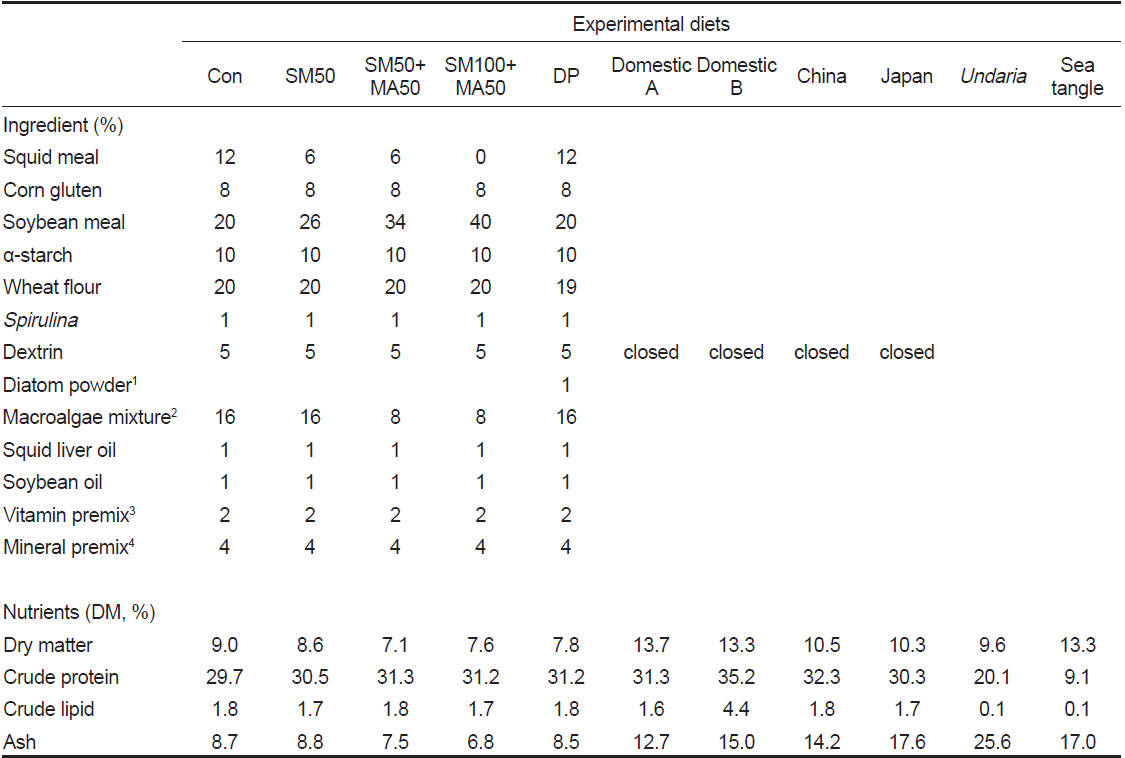
Ingredients (%, DM basis) and nutrient composition of the experimental diets
16주간의 사육실험 종료 시 각각의 실험구에서 생존한 전복 10마리씩을 무작위로 샘플하여 냉동보관(−70℃) 하였으며, 각 전복의 각장과 각폭은 digital caliper (Mitutoyo Corporation, Kawasaki, Japan)을 이용하여 측정하였고, 영양학적 상태 지수 측정을 위해 전중량에 대한 가식부의 비를 계산하였다.
실험사료와 전복 가식부의 일반성분분석은 AOAC (1990)에 따라 조단백질은 Kjeldahl method (Auto Kjeldahl System, Buchi B-324/435/412, Switzerland)과 조지방(에테르 추출법)을 분석하였으며, 조회분은 550℃ 회화로에서 4시간동안 태운 후 정량하였고, 수분은 105℃ dry oven에서 24시간 건조시킨 후 측정하였다. 실험 사료의 아미노산 분석은 high speed amino acid analyzer (Hitachi L-8800, Tokyo, Japan)을 이용하여 아미노산 조성을 분석하였으며, 지방산 분석은 Folch et al. (1957)의 방법에 따라 클로로폼과 메탄올 혼합액(2:1)으로 총 지질을 추출하여 14% BF3-MeOH (Sigma, St Louis, Mo, USA) 용액으로 지방산을 methylation 시킨 후, capillary column (SPTM-2560, 100 m×0.25 mm i.d., film thickness 0.20 μm, Supelco, Bellefonte, PA, USA)이 장착된 gas chromatograph (Truce GC, Thermo, USA)로 지방산 조성을 분석하였다.
One-way ANOVA와 Duncan’s multiple range test (Duncan 1955)로서 SAS version 9.3 program (SAS Institute, Cary, NC, USA)을 이용하여 각 실험구간의 유의성을 검정하였다.
실험에 이용된 사료의 아미노산 분석 결과 미역과 다시마에서 모든 필수아미노산(Arg, His, Ile, Leu, Lys, Met, Phe, Thr 및 Val)의 함량이 실험용 배합사료에 비해 낮게 나타났다(Table 2). 국내 시판사료(Domestic A, Domestic B)에서도 제조한 실험사료와 국외 시판사료(China, Japan)에 비하여 모든 필수아미노산 함량이 낮았다. 실험사료들의 지방산 분석 결과(Table 3), 미역과 다시마에서 n-3 HUFA (highly unsaturated fatty acid) 비율은 각각 25.96%와 21.48%로 나타나서 다른 실험사료들에 비해서 높게 나타났으나, 미역과 다시마에서의 지질 함량(0.1%)이 다른 실험사료들(1.6-4.4%)에 비하여 낮았기 때문에 미역과 다시마에서의 n-3 HUFA 함량은 낮은 것으로 나타났다. 미역과 다시마에서의 eicosapentaenoic acid (EPA, 20:5n-3) 비율이 각각11.76%와 5.16%로 나타났으나, docosahexaenoic acid (DHA, 22:6n-3)는 전혀 측정되지 않았다. 국내 상업용 시판사료(Domestic A, Domestic B)와 국외 상업용 시판사료(China, Japan)에서는 gamma-linolenic acid (18:3n-6)가 전혀 나타나지 않았다. 미역과 다시마는 단백질, 특히 필수아미노산과 지질 함량이 전복용 사료내 요구량(Uki et al., 1985a; Uki et al., 1986a, 1986b)을 충족시켜주지 못하기 때문에 전복의 성장에 크게 영향을 미칠 것으로 판단된다.
[Table 2.] Amino acid profiles (%, DM basis) of the experimental diets
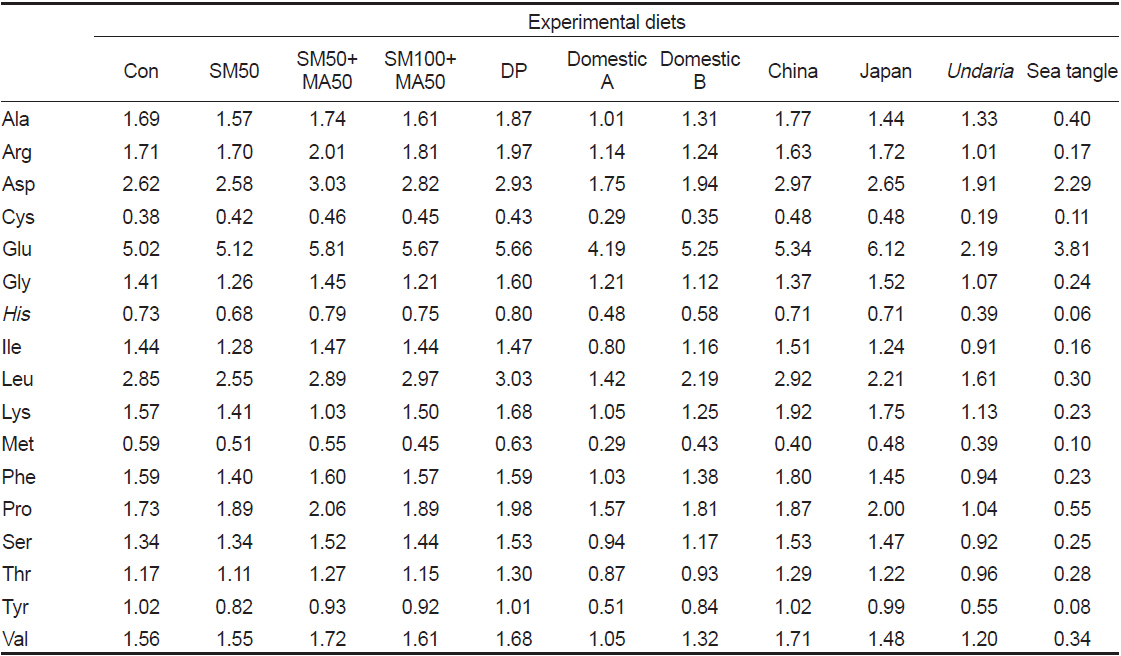
Amino acid profiles (%, DM basis) of the experimental diets
[Table 3.] Fatty acid profiles (% of total fatty acid) of the experimental diets
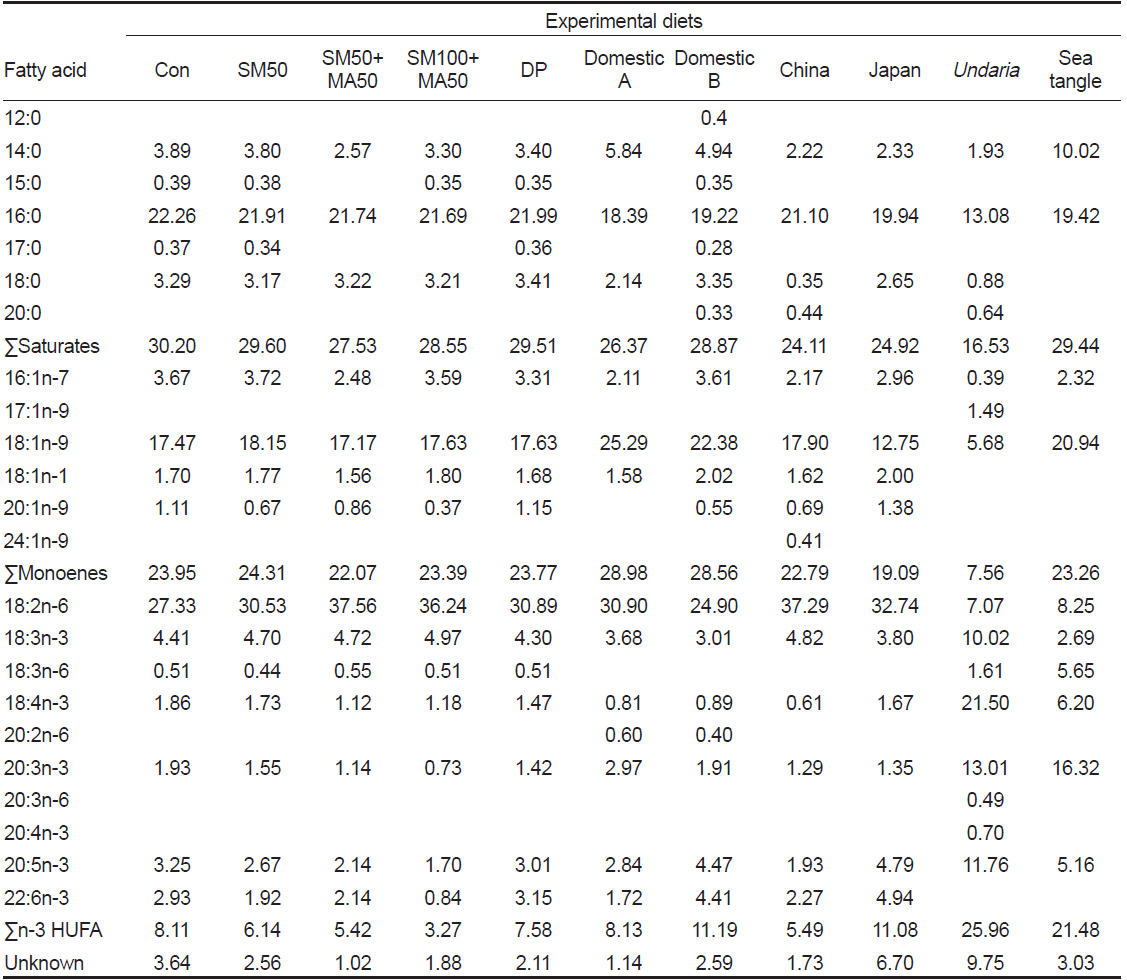
Fatty acid profiles (% of total fatty acid) of the experimental diets
실험사료를 16주간 공급한 전복의 성장 결과는 Table 4와 같다. 전복의 생존율(Survival)은 77.6-100%의 범위이었으며, Con, SM50, SM50+MA50, SM100+MA50, DP, China, Japan, 미역 및 다시마를 공급한 실험구가 국내 상업용 시판사료인 Domestic A와 Domestic B를 공급한 실험구보다 유의적으로 우수하였으며(
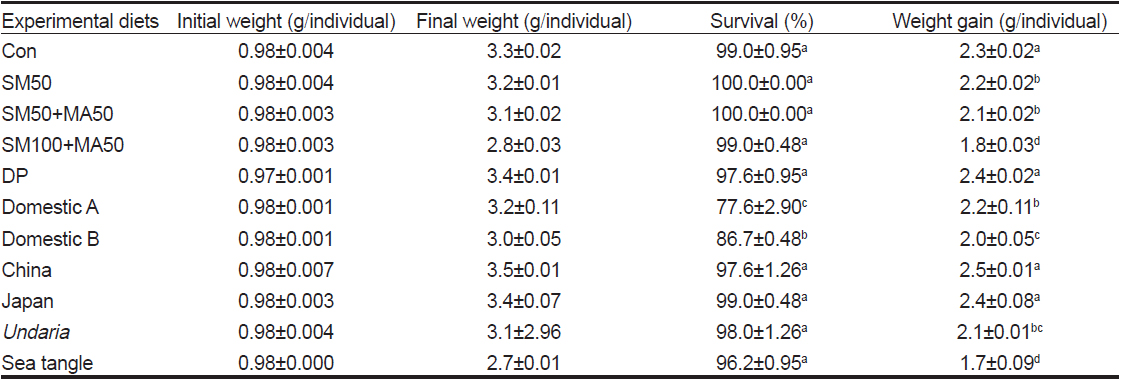
Survival (%) and weight gain (g/abalone) of juvenile abalone Haliotis discus hannai fed the experimental diets for 16 weeks
전복의 각장(shell length)은 DP, China와 Japan 사료 공급구가 대조구와 유의적인 차이는 없었으나(
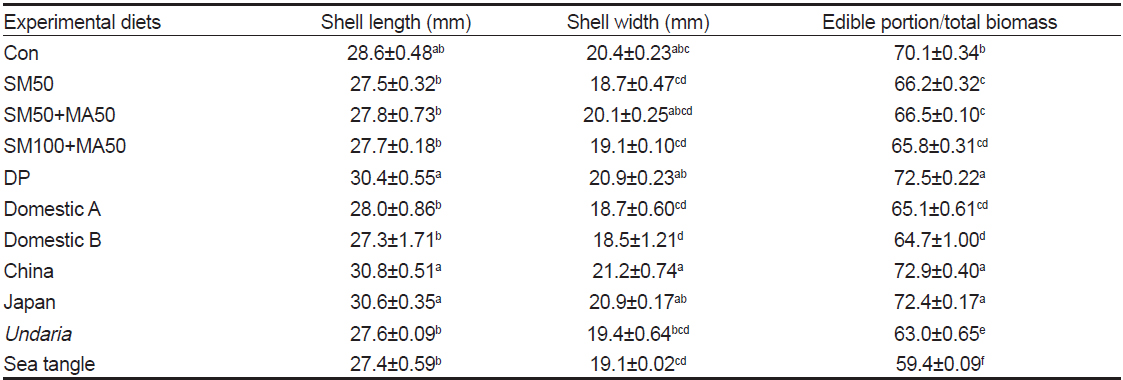
Shell length (mm), shell width (mm) and the ratio of edible portion to total biomass of juvenile abalone Haliotis discus hannai fed experimental diets for 16 weeks
미역과 다시마를 공급한 실험구는 다른 실험 사료를 공급한 실험구보다 유의적으로 낮게 나타났다(
전복의 사육실험 종료시 전복 가식부의 일반성분 분석 결과는 Table 6과 같다. 전복 가식부의 수분 함량은 77.0-80.3%의 범위로서 Domestic B 사료 공급구에서 대조구, SM50, SM100+MA50, DP 및 다시마 공급구보다 유의적으로 높은 값을 보였으나(
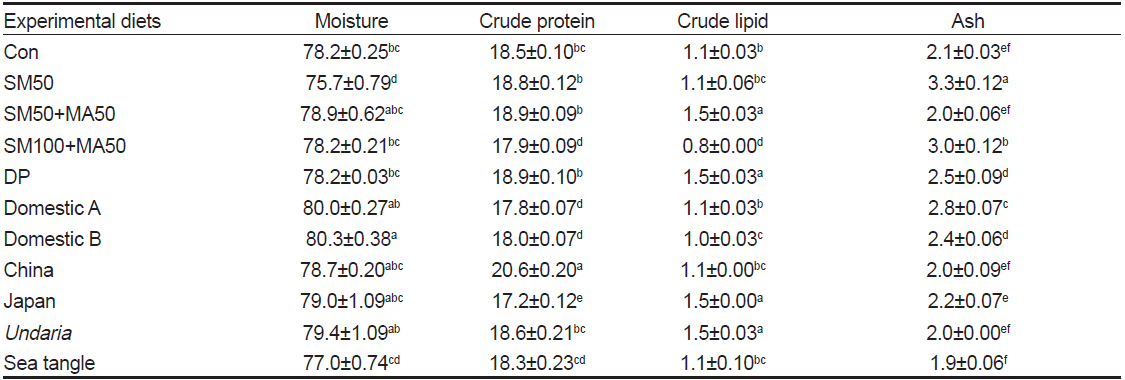
Chemical composition (%) of edible portion of juvenile abalone Haliotis discus hannai fed experimental diets for 16 weeks
이상의 결과를 고려할 때 전복용 배합사료내 단백질원으로 공급된 오징어분과 해조류 대체원으로서 대두박의 단독 대체 가능성은 제한적이었지만 전복용 배합사료내1%의 규조류 첨가는 전복 치패의 성장 개선 효과를 이루었으며, 일부 사료(SM50+MA50, SM100+MA50, Domestic B)를 제외한 대부분의 배합사료는 미역이나 다시마 공급구보다 우수한 성장을 보였다.





